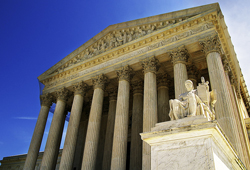 As we covered in a previous post, in April the Supreme Court will hear arguments regarding the BPCIA’s notice of commercial marketing requirement and patent dance provisions. Last week, the Biosimilars Council filed an amicus brief in support of Sandoz’s position with respect to both issues. The brief is available here.
As we covered in a previous post, in April the Supreme Court will hear arguments regarding the BPCIA’s notice of commercial marketing requirement and patent dance provisions. Last week, the Biosimilars Council filed an amicus brief in support of Sandoz’s position with respect to both issues. The brief is available here.
The amicus brief makes three primary arguments. First, the Biosimilars Council contends that prohibiting biosimilar applicants from providing an effective notice of commercial marketing until after FDA licensure would improperly extend the 12-year market exclusivity period enjoyed by biologic reference product sponsors by an extra six months in every instance. The Council states that “the urgent need to access the cost savings that biosimilars could bring was the key motivation for adopting the BPCIA.” The Council’s brief traces the legislative history of the BPCIA in which numerous legislators and industry groups discussed the 12-year exclusivity period ultimately adopted in the BPCIA. The Council says that the “lack of any mention, whatsoever, of a 12 ½ year exclusivity period in the legislative history or contemporaneous press reports is irreconcilable with the notion of a 12 ½ period that applies in every case.” The Council’s brief further contends that extending biologic sponsors’ exclusivity period by an extra six months will cost patents, insurers, and taxpayers billions of dollars and may adversely affect biosimilar development.
Second, the Council states that requiring notice to follow FDA approval is not necessary for post-notice patent litigation to take place. The brief notes that the Federal Circuit’s decision was based on its belief that Congress intended notice, and post-notice litigation, to occur only after there is a “fully crystallized controversy” following FDA approval. The Council contends that if “Congress had intended patent litigation to occur only after there was a ‘fully-crystallized controversy’ post-licensure, it would not have permitted—indeed, encouraged—infringements lawsuits to be filed shortly after an applicant submits a biosimilar application and long before approval. The Council also states that post-licensure notice, followed by a 180-day waiting period before marketing can begin “would be nonsensical” in many instances, noting that “there may be no active patents left once a biosimilar application is filed,” after patent-dance-related litigation, or after the end of the sponsor’s 12-year exclusivity period. The Council states that in “each of these situations, all that is left to do during the 180-day period is wait for the sake of waiting.”
Third, the Council states that it is not necessary to require every biosimilar applicant to engage in the patent dance or prohibit effective notice until after FDA approval to protect biologic sponsors from biosimilar developers’ secretly filing aBLAs or launching biosimilar products. The Council states that the biosimilar development and filing pipeline are “both robust and transparent” given statutory and regulatory disclosure requirements and market pressures to which pharmaceutical companies are subject. Given these “practical realities,” the Council contends “there is no reason to suggest that a stealth filing or launch has ever been or could ever realistically be an actually concern, and it would be nonsensical to adopt a countertextual interpretation based on such imagined pragmatic worries.”
Stay tuned to Big Molecule Watch for more coverage of the amicus briefs filed in Sandoz v. Amgen last week.
